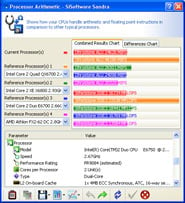Intel Core 2 Duo E6750 Performance And Overclocking
Test Systems and SiSoft SANDRA

How we configured our test systems: When configuring our test systems for this article, we first entered their respective system BIOS and set each board to its "Optimized" or "High performance Defaults". We then saved the settings, re-entered the BIOS and set memory timings for DDR2-800 with 4,4,4,12 timings. The hard drives were then formatted, and Windows XP Professional (SP2) was installed. When the Windows installation was complete, we installed the drivers necessary for our components, and removed Windows Messenger from the system. Auto-Updating and System Restore were then disabled and we set up a 1024MB permanent page file on the same partition as the Windows installation. Lastly, we set Windows XP's Visual Effects to "best performance," installed all of our benchmarking software, defragged the hard drives, and ran all of the tests.
|
|
|
|
|
|
We began our testing with SiSoftware's SANDRA XI, the System ANalyzer, Diagnostic and Reporting Assistant. We ran six of the built-in subsystem tests that partially comprise the SANDRA XI suite with the Core 2 Duo E6750 ( CPU Arithmetic, Multimedia, Multi-Core Efficiency, Memory, Cache, and Memory Latency) . All of the scores reported below were taken with the processor running at its default clock speed of 2.6GHz.
The results reported by the various SANDRA test modules we ran fell right in line with our expectations. Considering the fact that the E6750 is clocked at the same speed as the E6700, their performances were quite similar according to SANDRA. The additional bandwidth afforded by the E6750's higher clocked FSB give it a slight edge in a couple of the tests, but where its advantage is most apparent is in the Memory Bandwidth benchmark. In the Memory Bandwidth test, the E6750 / P35 / DDR2 combo hit 6.3GB/s, whereas an E6700 / P965 / DDR2 combo typically hovers in the 5.6GB/s range. Somewhat surprisingly, the Cache and Memory and Memory Latency tests, the E6750 doesn't fare all that well against the E6700.












